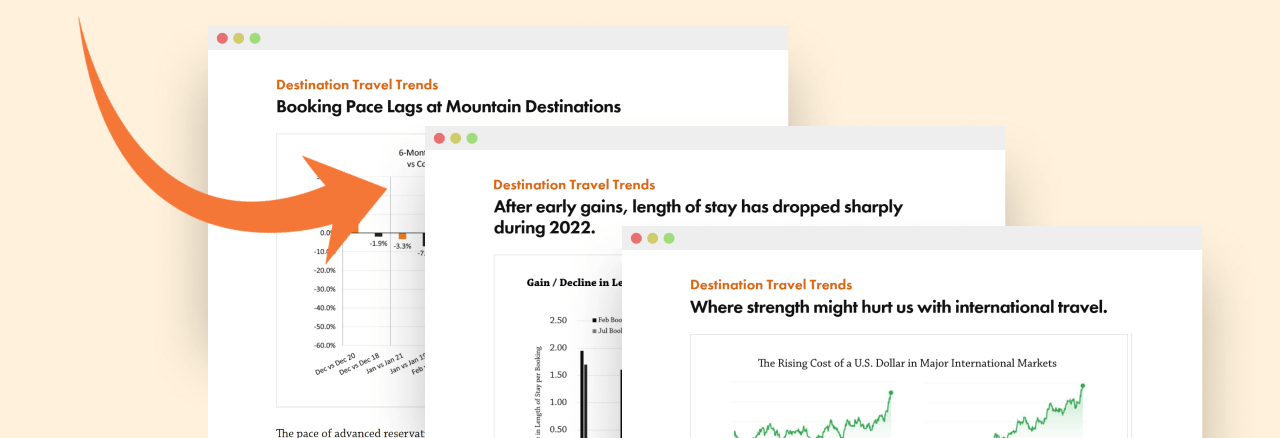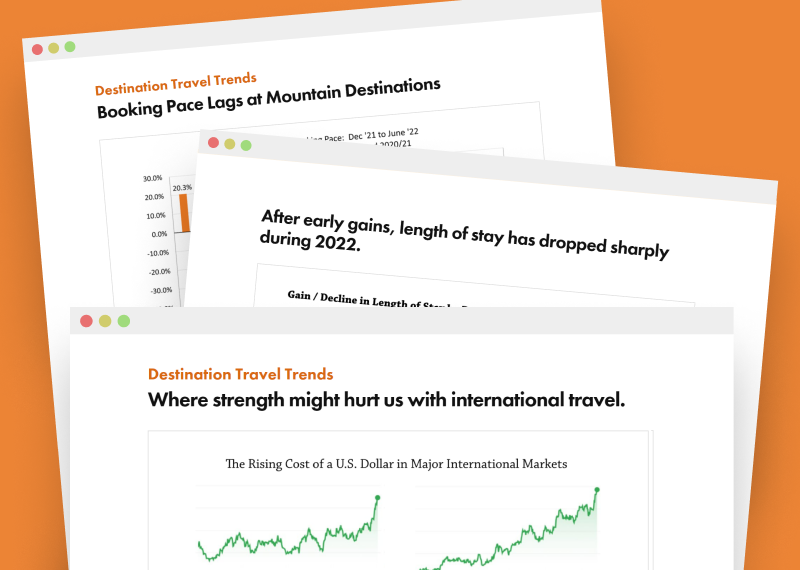

 Stacey Mullen
Stacey Mullen
Consistent, and in some cases, abundant snowfall across many western mountain resorts compared to last year has worked its usual magic to give November bookings a boost, particularly for November and December arrivals. But economic headwinds are still blowing and have prevented 2022 from sustaining 2021’s rebound recovery from the pandemic, and according to the most recently released Market Briefing from DestiMetrics,* part of the Business Intelligence division of Inntopia, those economic variables are likely to remain a challenge through the remainder of the winter. Their most recent seasonal forecast for mountain lodging covering 17 mountain communities across seven states includes data collected through Nov. 30.
Decent November to launch winter season
A quick comparison to the past three years for the month of November shows how both occupancy and daily rates have evolved from before, during, and after the pandemic. Compared to one year ago, actual occupancy for November was down 4.7 percent and the Average Daily Rate (ADR) was virtually unchanged—down 0.6 percent. Compared to the pre-vaccine November of 2020, occupancy this November was up a healthy 15.4 percent with ADR up an equally solid 13.3 percent. And compared to the pre-pandemic November of 2019, occupancy was up 1.5 percent, but daily rates are up a dramatic 34.9 percent.
Winter moves into full swing
The winter of 2022-23 is looking more typical than the past few years but economic uncertainty and societal changes ranging from work schedules to availability of seasonal employees continues to impact destination travel. As of Nov. 30, on-the-books occupancy for the full winter from November through April is down 5.6 percent compared to last year with declines in all winter months except January. In contrast, aggregated daily rates for the season are up 9.1 percent in a year-over-year comparison and are showing increases in every month except a scant decline in November.
Looking at a two-year comparison, the dramatic 66.9 percent increase in seasonal occupancy this year over the uncertainty of the 2020-21 season at this same time is expected–as is the 43.8 percent gain in daily rates this year compared to two years ago. And when compared to the winter season of 2019-20 due to the pandemic, occupancy this year is up 4.5 percent with the ADR up an impressive 41.1 percent.
Snowfall gets credit for uptick in bookings
Widespread snowfall across much of the West flexed some vital booking muscle during the month of November. November bookings made for arrivals for the months of November and December were up 24 and 21.5 percent respectively as consumer were eager to hit the slopes. Last year’s strong economy meant significant bookings in November ’21 for January through April–a surge that couldn’t be replicated this year, hindered by economic slowing. The result is a 3.3 percent decline in seasonal bookings made in November–despite the strong gains for November and December.
“That 3.3 percent decline in overall bookings is entirely due to soft bookings for arrivals from January through April, but that’s an improvement from the end of October data when bookings were down 4.1 percent,” explained Tom Foley, senior vice president of Business Intelligence for Inntopia. “This is the tenth month in 2022 that the year-over-year booking pace has been down as consumers respond to economic declines. But the big boost in bookings made in November for arrivals in November and December was very welcome and reinforces what we’ve reported for the past 20 years—which is that good snow will move the booking needle, even with economic uncertainty and challenges.”
Economic indicators
For the second consecutive month, the Dow Jones Industrial Average (DJIA) increased sharply during November by adding 5.7 percent to close at 34,589.8 points and building on October’s strong rebound. This is the highest level for the Dow since last March as stocks gained strength on positive inflation data in October and optimism about more modest interest rate hikes by the Federal Reserve Bank. This upward trajectory has mirrored the S&P 500 and represents investment recovery and gains for consumers which marks a welcome shift from deep losses earlier in the year—and is likely fueling stronger than expected consumer spending.
In marked contrast to the financial markets, both the Consumer Confidence Index (CCI) and the Consumer Sentiment Index (CSI)dropped. The CCI dipped two percent and marks the seventh time this year the Index has dropped as consumers outlook about jobs and earnings declined triggered by rising food and energy prices that both rose in November. The CSI declined five percent to 56.8 points and is only slightly above its all-time low of 50 points in June. Food and energy costs impacted this decrease along with the increased costs of debt and borrowing.
“While mountain consumers score considerably higher than the national consumer index scores, we are seeing clear evidence of price-induced softening in mountain travel buying this month,” observed Foley
The national Unemployment Rate remained at 3.7 percent in November while employers added a stronger than expected 263,000 new jobs to payrolls and wages for the year were up 5.1 percent—somewhat slower than in recent months. The Leisure and Hospitality industry which has been the slowest sector to recover post-pandemic, added 88,000 new jobs but still remains nearly one million jobs fewer than February 2020.
Recent news that is likely to boost consumer confidence in December was the announcement that the national Inflation Rate declined to 7.1 percent in November, the fifth decline from its high of 9.1 percent in June. Month-over-month prices also declined—down 0.1 percent from October as sharp reduction in the price of gasoline brought down the overall average even though food and energy prices remain near record highs. Despite those high prices, consumers broke spending records on Black Friday and Cyber Monday as stockpiles of inventory at many retailers resulted in deep discounts on many products.
Of note
*Room Nights Available (RNA) are down for the winter season which impacts the occupancy data. Although the available inventory has improved from last month, there are currently 1.95 percent fewer nights available for rent at participating mountain resorts this winter than last winter with declines in all months from December through April.
*Bookings made in November for arrival in December were the third strongest on record—behind only November 2009 when recovery from the Great Recession was spurring bookings, and last November (2021) when a strong economy and the post-pandemic pent- up demand combined to send bookings surging.
Length-of-Stay that climbed dramatically during 2020 and 2021, continued to decline in November with bookings during the month down an average of 0.39 nights compared to the pre-pandemic benchmark. Declines were noted for all arrival days of the week with Mondays dropping the most and Fridays remaining the most resilient although still down slightly.
“Ongoing declines in rooms available for nightly rentals is masking the actual number of room nights being booked which is driven by both lower volume and shorter lengths-of-stay,” clarified Foley. “But despite economic pressures, exceptionally strong daily rates are currently offsetting the lower occupancy figures and generating more revenue per night. But the financial issues are real and likely to last through the winter. And, while continued good snowfall can mitigate tough economic times, if Mother Nature doesn’t deliver, it will create challenges for lodging properties to manage revenue—with either a potential decrease in visitors or lowering rates to entice additional skiers while maintaining service level with smaller staffs,” he concluded.
Have a question? Just ask.

Tyler Maynard
SVP of Business Development
Ski / Golf / Destination Research
Schedule a Call with Tyler→

Doug Kellogg
Director of Business Development
Hospitality / Attractions
Schedule a Call with Doug→
If you're a current Inntopia customer, contact support directly for the quickest response →
Request Demo
A member of our team will get back to you ASAP to schedule a convenient time.



